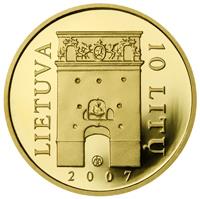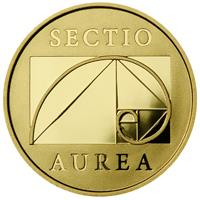10 Litų - Gate of Dawn (Ostra Brama) (2007)
Features
| Denomination | 10 Litų |
| Catalog Number | KM# 160 |
| Weight (g) | 1.24 |
| Diameter (mm) | 13.92 |
| Shape: | Round |
| Composition: | Gold (.999) |
| Not Magnetic | |
| Metal Value (USD) | 79.55 |
| Orientation | Medal orientation ↑↑ |
| Commemorative | |
| Demonetized | |
| Non Circulating | |
| Demonetized | 2015-01-15 |
Obverse
Engraved by Liudas Parulskis and Rytas Jonas Belevičius
Lettering:
LIETUVA
10 LITŲ
2007
Description:
One of the most significant historical and architectural monuments of Vilnius — Aušros Vartai, which reflects the proportions of the golden mean. The attic of Aušros Vartai features Vytis, the symbol on the Coat of Arms of the Republic of Lithuania. The inscriptions LIETUVA, 10 LITŲ and 2007 are arranged in a circle around it.
LIETUVA
10 LITŲ
2007
Description:
One of the most significant historical and architectural monuments of Vilnius — Aušros Vartai, which reflects the proportions of the golden mean. The attic of Aušros Vartai features Vytis, the symbol on the Coat of Arms of the Republic of Lithuania. The inscriptions LIETUVA, 10 LITŲ and 2007 are arranged in a circle around it.
Reverse
Engraved by Liudas Parulskis and Rytas Jonas Belevičius
Lettering:
SECTIO AUREA
Description:
Formula of the principle — the golden section (Sectio Aurea) — used in architecture from antiquity, which is expressed in a geometrical figure — the rectangle. The golden section, which represents the principle of a perfect division of a line into two segments so that the ratio of the whole to the larger part is the same as the ratio of the larger part to the smaller, was considered an aesthetically perfect, or golden, proportion. In Renaissance, this formula, used in architecture, was applied to the proportions of the portrayal of a human figure, the composition of art works, etc. The figure is encircled with the inscription SECTIO AUREA.
SECTIO AUREA
Description:
Formula of the principle — the golden section (Sectio Aurea) — used in architecture from antiquity, which is expressed in a geometrical figure — the rectangle. The golden section, which represents the principle of a perfect division of a line into two segments so that the ratio of the whole to the larger part is the same as the ratio of the larger part to the smaller, was considered an aesthetically perfect, or golden, proportion. In Renaissance, this formula, used in architecture, was applied to the proportions of the portrayal of a human figure, the composition of art works, etc. The figure is encircled with the inscription SECTIO AUREA.
Edge
Description:
Milled
Milled
| Year | Mintage | Comment | Rarity |
|---|---|---|---|
| 2007 | 15,000 | Proof | Unknown |




